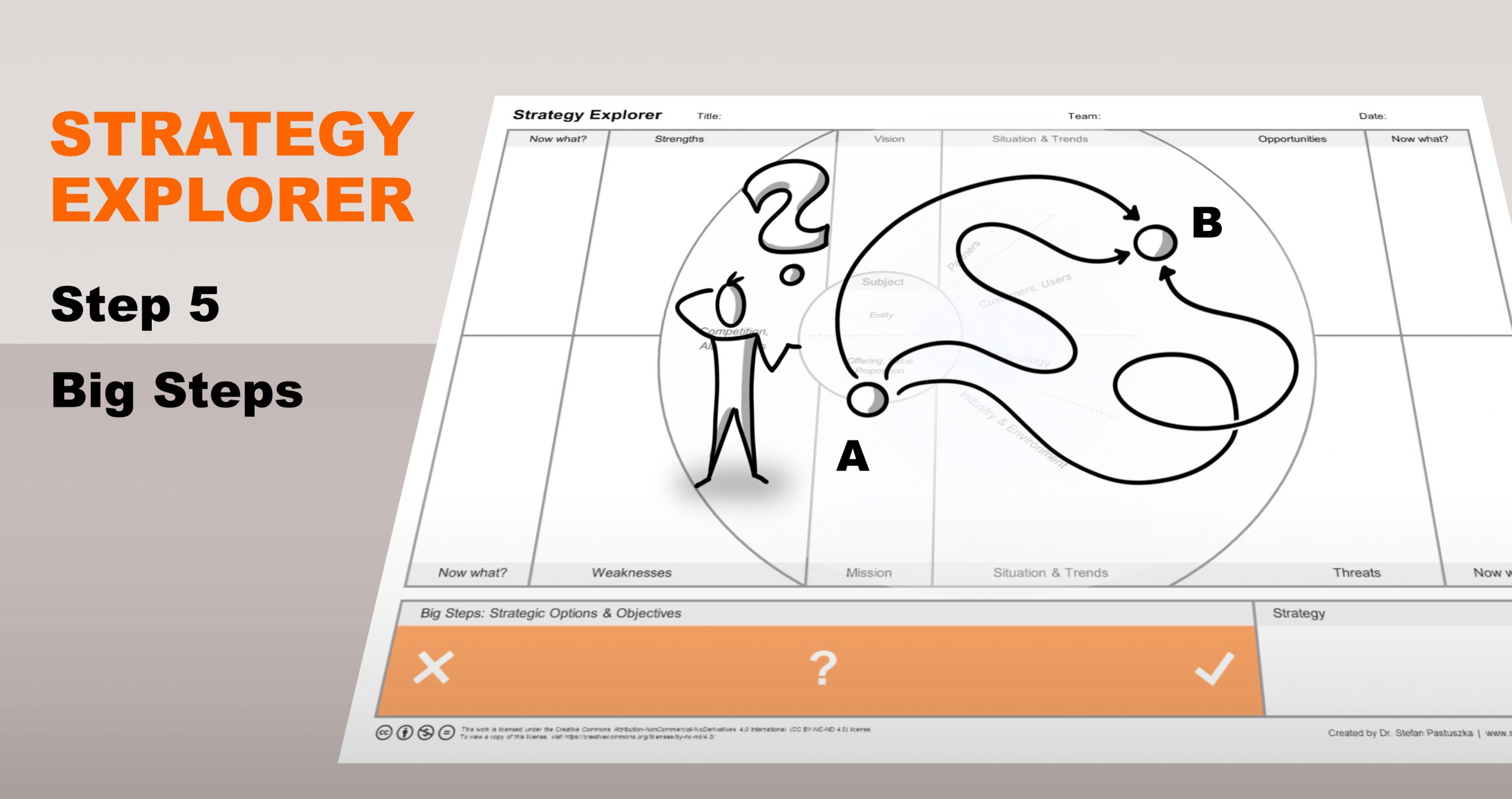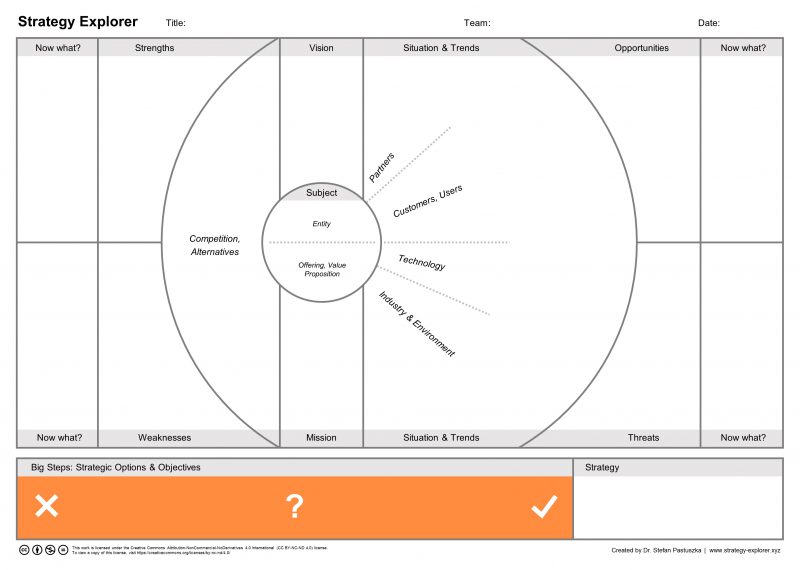How can we reach our overarching goals and make our vision reality? Good question, and not that easy to answer. A strategy describes a way to achieve a specific goal. And in most cases, there are different ways to reach this goal, each consisting of big steps that could bring you closer. Some of these big steps are exclusive (i.e., you can do one or the other, but not both), while others can be readily combined. Before we can conclude on the most promising way forward, we must first identify and consider the alternatives – at least as many as we can conceive. This is the fifth step in the Strategy Explorer process: deriving and prioritizing Big Steps in the form of strategic options and objectives.
Identifying Big Steps
In the Strategy Explorer, the field “Big Steps: Strategic Options and Objectives” is used to first collect the potential steps that will bring you closer to the goals lined out in your vision. In principle, this is an ideation exercise that builds on the previous work and can be enriched with additional out-of-the-box thinking. The content you will be looking for are qualitative goals, measures and action fields of sufficiently strategic level. The insight required can be generated by three different ways, as described in the graphic.
In the previous “SWOT – Now what?” step, you probably came up with plenty of activities and goals that could or should be undertaken to achieve the given goals. This is the main source of input for the Big Steps. However, as this input consists of items of various granularity – from minor operative stuff up to really strategic moves – a step of filtering, consolidating and clustering is required. The truly strategic moves can be directly copied to the Big Steps field (make sure not to simply move the adhesive notes form the upper to the lower part of the poster: write new notes in order to keep the picture intact). The “smaller” items might belong to specific action fields that are important and should be included in the Big Steps in a newly formulated manner. Finally, there will probably be items which are important, but are not at a level to constitute a relevant big step for your potential future strategy: they are important and should be taken care of, but later and elsewhere, so they will not be transferred into the Big Steps field.
A second approach to identify big steps involves systematically combining the insights generated in the SWOT fields with each other: How can the strengths be used to exploit certain opportunities or to ameliorate or avoid the risks? How can weaknesses be overcome by grabbing one of the opportunities, and which weaknesses need to be addressed in order to be protected from the threats?
The third, rather intuitive approach consists in free ideation, focused on the question “what do we really need to do to make our vision a reality?” In order for this to work, it is essential to take a step back from the detailed work from before to regard the complete picture. If you manage to get yourself and your team into a creative state of mind, this approach can lead to inspiring out-of-the box ideas. Be aware that a healthy dose of open-mindedness is required, as the ideas generated here might contain strategic moves which are radical and surprising. This is exactly the stuff you should be looking for. If you manage to project yourself into the future as lined out by your vision and take a look back, you might identify the required steps to get there without the constraints of your current day-to-day work. This is called “backcasting” by futurologists.
Prioritization and selection
Now we are getting into the harder phase of the process. Harder, because all previous steps had to do with analyzing and ideating – nobody hurt, yet. By prioritizing the big steps, i.e. the strategic options and objectives, the entrepreneurial decision for a certain strategy is prepared. You will need to make up your mind now which options should be considered for the final strategy and which ones should be ignored.
As a team that has sufficient acumen in the line of business you are pursuing, and after all the previous discussions, you should have a certain idea which options would be the relevant ones. Therefore, the field “Big Steps” in the Strategy Explorer provides a linear scale to prioritize your options:
- Right hand side: yes, should be done!
- Middle: maybe, or not now…
- Left hand side: no, rather not.
Of course, this linear scale is based on intuitively assessing and compounding various parameters. If you are not sure, you can use an additional step – outside the Strategy Explorer – to get the prioritization right. Typically, strategic options are weighed in a relative manner according to the parameters of suitability (to achieve the overarching goal), feasibility and acceptance (by stakeholders). Therefore, it makes sense to prepare a flip chart or moderation paper with a coordinate system (suitability vs. feasibility). Place your options in this coordinate system and re-arrange them until you are satisfied with the resulting picture. The most promising options should be found in the upper right corner. However, acceptance has still to be discussed: even the apparently most suitable and feasible option can lead to disaster if it faces a severe acceptance problem.
As soon as you have identified the most promising big steps, you are close to finalizing your strategy. However, you may want to further substantiate the viability of the preferred options, especially if they encompass massive change or are not sufficiently under your own control.
In the next article we will be discussing the final step of formulating the most promising way forward. I wish you good ideas, productive discussions and a clear picture regarding the preferable options to reach your vision! Do not hesitate to contact me in case of questions and comments – I am happy to learn about your individual experiences with the Strategy Explorer.



